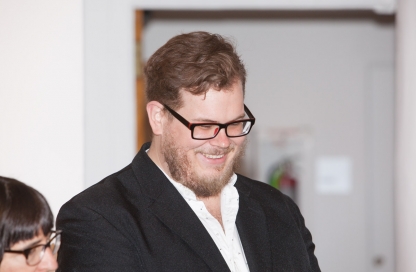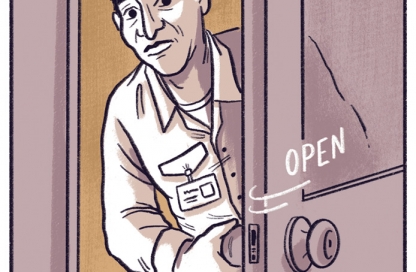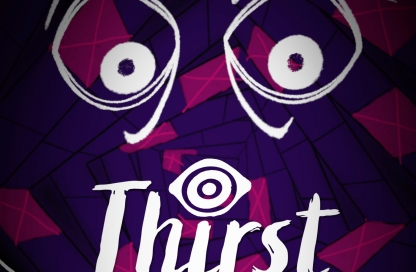Learning from the grads: Alex Beguez interviews MFAVN alumnae about their thesis projects
Wow. It seems like only yesterday I set about my journey as grad student, blissfully unaware of all the hard work, sleepless nights, and hair-pulling sessions that awaited me.
These past summer and fall semesters, I’ve been diligently working on my thesis project: a webcomic set in the far distant future where little is left in the universe and the remaining peoples cling desperately to life. Or at least that’s what it’s about this week. This comic will be my longest to date and the most complex narrative I’ve set out to write. There have been many times during the past two semesters that I’ve been sure I knew how my story was going to end, only to be left unsatisfied and bash my head against the wall repeatedly until a good idea fell out.

Early concept work from my thesis project, tentatively titled The Offering
The important thing to remember when you’re stuck is that you’re not the only one who’s gone through this (and certainly not the last). Sometimes you need to talk about your project out loud with friends, colleagues and mentors instead of living inside your head. Even I need reminding of this! So I reached out to alumnae from the inaugural Class of 2015 and asked them about their thesis experience.
Could you talk a little about your thesis project?
Jenny Goldstick: My thesis project is an interactive, sequential digital experience representing my memory of first heartbreak. I attempted to apply logical principles I use in my professional practice as a designer/infographic maker to diagram my own emotional connection to this highly subjective, personal memory. In doing so, I hoped to create an experience that reflects the feeling of the memory, and the feeling of memories in general.
Anna Eveslage: For my thesis project, I worked on a photo book called Eating Alone, which is a collection of short prose vignettes and accompanying photographs of people (as you might guess) eating alone. I was interested in exploring different ways different people might experience aloneness through a common thread that we can all relate to. I tried to look at a wide range of experiences, focusing on the emotion of the moment through the characters’ thoughts and actions. Some of them revel in their solitude, some are suffocated by their loneliness, others are reflective or terrified or relieved.
The work I make is fiction, but a very grounded fiction. I want people to relate to my work on a personal level by seeing themselves or people they know in the characters. I want them to compare their own experiences to that of the characters and have a reaction. I think fictional photography can do that especially well. We react to the characters as real people, because the actors are real people, but with fiction I can have full control over the idea I want to communicate. In that way, the work can really become an exchange of thoughts between myself and the reader.
Nadia DeLane: Spilt Milk is a stop motion animated film and installation about time, identity and visibility. The relationship between my main character, Carmen, and her invisible friend, The Clear One, emerged from the adage “Don’t cry over spilt milk”. I wanted a project that destabilized time. We are told that our mistakes are irreversible aspects of an everlasting past. The looping the film, mimics cyclical rather than linear time. My characters get do-overs when it begins again.
From a process perspective, my project required several drafts and intricate sewing. My characters are handmade and my backgrounds are multi-media collages. Texture is something that I wanted, so that was the emphasis. Over the course of a year, I stopped counting how many hours it took to create the film and starting to think about how I wanted each frame to look.

Still from Jenny Goldstick’s thesis project, This Is My Memory Of First Heartbreak, Which I Can’t Quite Piece Back Together.
How often did your story change? How close is the final product to its original conceit?
Jenny: My story changed constantly, most drastically in the fall, but even into the spring, and a little bit into the summer. Somehow the final product is close to the original conceit, though! When I read back to my initial pitch and mission statement, I see that I actually did pretty much exactly what I said I would do.
Anna: It really didn’t change much, to be honest. For the type of work I was doing (which is very production-heavy and takes a lot of coordination with a lot of people, places and things) I had to dive in head first and didn’t really have time to change the fundamentals of the project. I would say the thing that changed the most was in the writing, but more the pushing the emotion and fine-tuning. The principals of the characters stayed the same since casting and locations were already being arranged. I also cut a few entire vignettes in the original drafts for the final collection.
Nadia: For the first six months my story changed slightly at least once every two weeks. Even if I didn’t share every alteration with my colleagues, I made notes on my studio walls or I would take mental notes. It took time for me to figure out what the story’s purpose was. I had basic plot points down and I had an idea about the characters, but several concepts floated around me. Unseen aspects of the human condition, psychological horror, family and blackness were just a few of themes I wanted to address. The final version of Spilt Milk is the original story’s grand daughter.

Photograph from Anna Eveslage’s thesis project, Eating Alone.
While working on your project, did you suffer bouts of creative block? If so, how did you get past it?
Jenny: I absolutely suffered bouts of creative block! I got past it by continuing to push, and really hard. I feel like I was driving in 5th gear with a flat tire and rims busting out by the end. I don’t recommend this method; it made me unhappy working on the project at certain points. I wish I had felt more confident in my ability to do a good job on the project and let myself walk away from it and take a breather when I was experiencing blocks.
Anna: I didn’t, really. I think, on some level, my brain knew I didn’t have time for that, so it spared me. Or maybe I just had a lot to say about being alone. But really, I take deadlines very seriously. My obsession with timeliness reaches a molecular (read: pathological) level.
Nadia: My thesis mentor, Catya Plate, knows that my story took on several shapes. It was a journey. I had too many themes which did prove challenging. It was difficult to synthesize and simplify my message because I wanted one project to do so much work. There came a point where I didn’t see a story anymore I just saw pieces. So in a way that was a block… not being able to put a bow on things was frustrating.
I got through it by writing every idea down and prioritizing. I made doodles and storyboards. I spent weeks finalizing my settings and characters. Then, I went into shooting. Things took a turn once I got the finalized characters involved. Carmen began to make her own decisions. Almost as if she told me, “I wouldn’t do this scene that way. You should change it.” So, I changed it.

Carmen, the protagonist in Nadia DeLane’s thesis project, Split Milk.
Now that your thesis project is out there in the world, how do you feel about it?
Jenny: Looking back, I feel good about the experience overall because I learned so much. Distance from the project has also given me perspective about the project’s place in the larger context of my body of work. It is definitely the largest independent project I have ever made, and I think it can only make more sense if I continue to make more work like it. I see the importance of simply continuing to make independent work and to follow my intuition in order to keep finding my voice. Then, of course, I will map out the entire experience and make an interactive project out of it!
Anna: I’d like to get it out into the world more. I’ve mostly stepped away from the project since graduation, but I’m excited to look at it again with fresh eyes and see where it can go. I’d like to start searching for a publisher for the work and am in the (very) early stages of doing so.
Nadia: I wanted it to convey a message about a tiny brown girl struggling to remember a past with her invisible other friend. The emotive aspects of the film fulfilled my expectations because I got to focus on an offbeat friendship. Generally, I feel good about it. I look forward to more opportunities to share my film. Of course I have things that I would like to change. I probably will approach my animating and editing process much differently for the next film. Once I’ve given Spilt Milk some time to flow “out there” I can concentrate on the sequel.


